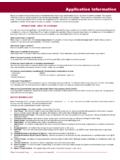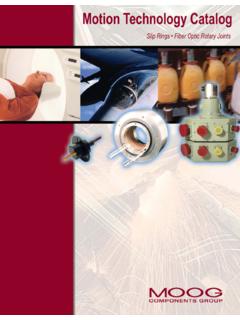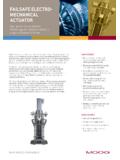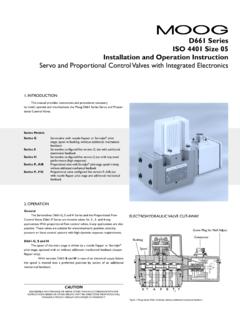Transcription of MCG DISTANCE - BASED TRAINING Document Number
1 2007 moog , Inc. 00-00-07 For more information : 1 MCG DISTANCE - BASED TRAINING Document Number 104 MCG DISTANCE - BASED TRAINING - APPLICATION NOTE#4 KM - Motor Constant - THE GREAT EQUALIZER One of the most often overlooked parameters of direct current motors (both brush and brushless) is the Km or motor constant. The motor constant or Km defines the ability of the motor to transform electrical power to mechanical power and is a valuable tool for the application engineer particularly for recommending a best fit replacement for a competitor s motor. Although motor constant does not address thermal or other viscous losses, it is still useful for getting one into the ballpark. Regarding motor constant: Motor Constant is a figure of merit used to compare the relative efficiencies and output power capabilities of different motors. Km defines the ability of the motor to transform electrical power to mechanical power. Motor Constant is calculated by the following equation (in English units): o Km = Kt/ Rt - where Kt is the torque sensitivity ( ) and Rt is the terminal resistance (ohms) o Units for Km are watts (in English units) As can be seen from the above equation, the lower the motor s resistance the higher the Km will be.
2 Physical motor size can be deceiving! It is sort of intuitive to think a much larger motor will be more powerful than a smaller motor but this may not be the case. How then would we determine which is the more powerful motor? By calculating the motor constant. Customers are notorious for not providing complete specifications, making it difficult if not impossible to recommend a best fit alternative. However if we can get the customer to share the KT and RT of the motor, using the equation for calculating motor constant, we can make a relatively good recommendation. Knowing how to calculate motor constant is invaluable in trying to recommend a best fit equivalent for competitor s units. Now that the background is in place, let s put this new-found knowledge to work: Example #1: Using the MCG Motor Catalog (and without peeking), calculate the motor constant for a BN23-28MG-01LH This motor has a KT of and a RT of ohms. KM = KT/ R = ohms = watts 2007 moog , Inc.
3 00-00-07 For more information : 2 Example #2: A C34-L70W10 is inches in diameter and inches long. The volume of this motor is cubic inches.(treating the motor as a cylinder). A BN34-35AF-02LH is inches in diameter and inches long. The volume of this motor is cubic inches (again treating the motor as a cylinder). The C34-L70W10 is obviously a much larger motor. Which motor however is more powerful? Using KM, the C34-L70W10 has a KM of watts. The BN34-35AF-02LH has a KM of watts. From this you can see the much smaller motor is more powerful than the larger motor. Example #3: A customer comes in looking for a best fit replacement for a SLMTI motor. The motor data is as follows: Winding Data at 48 VDC (Approximate) PARAMETER UNITS VALUE Torque Constant, Kt oz-in/A Voltage Constant, Ke V/kRPM No Load Speed, NLS RPM 10992 Electrical Time Constant, te mS Mechanical Time Constant, Sensorless, tm mS Mechanical Time Constant, w/Halls, tm mS Resistance at 25 C, Rm Ohm Inductance, Lm mH Max.
4 Continuous Power Output at 100 C Rise W Max. Continuous Torque Output at 100 C Rise oz-in Max. Continuous Speed Output at 100 C Rise RPM 959 What MCG brushless motor would you recommend as a best fit replacement? Using KM as a figure of merit, we see the SLMTI motor has a KT of and a RT of ohms. Calculating KM we find this motor has a KM of watts. When we recommend an 2007 moog , Inc. 00-00-07 For more information : 3 alternative motor we want to match the KM as closely as possible - to insure the power is equivalent - as well as match the KT as closely as possible - to insure the speed is equivalent. So I m going to look for a brushless motor with a KM as close to watts and a KT as close to as possible. My recommendation would be: BN23-13MG-03LH - this motor has a KT of and a KM of watts. The customer may need a slight winding adjustment to get closer but this is a good baseline from which to start. Example #4: You might want to try this one on your own!
5 A customer has sent in the following data for a Bodine brush motor but wants to replace it with a brushless motor. What brushless motor would you recommend? (Caution - look at the units - conversions may be necessary!): Specifications Model Number 6230 [CAD Drawings] Category 180V, Metric Mounting Provisions Speed (rpm) 3000 Rated Torque (Nm) .50 Amps Motor Watts 155 KT (Nm/A) .52 KE (V/krpm) 53 Winding Resistance (ohms) Winding Inductance (mH) N/A Armature Inertia (kg-mm2) 270 Radial Load (N) 240 Length XH (mm) Weight (kg) Product Type 33A5 BEPM Winding 180V Accessory Shaft NO Connection Diagram 074 10097 In recapping KM - Motor Constant: Motor Constant is a figure of merit used to compare the relative efficiencies and output power capabilities of different motors. Km defines the ability of the motor to transform electrical power to mechanical power. Motor Constant is calculated by the following equation (in English units): o Km = Kt/ Rt - where Kt is the torque sensitivity ( ) and Rt is the terminal resistance (ohms) o Units for Km are watts (in English units) 2007 moog , Inc.
6 00-00-07 For more information : 4 As can be seen from the above equation, the lower the motor s resistance the higher the Km will be. Physical motor size can be deceiving! It is sort of intuitive to think a much larger motor will be more powerful than a smaller motor but this may not be the case. How then would we determine which is the more powerful motor? By calculating the motor constant. Hope this was helpful! More to Robbie Queen - Sales Manager MCG Murphy 1/16/2008



